语言学--SEMANTICS
- 格式:ppt
- 大小:324.50 KB
- 文档页数:27

第六章语义学一、导读6.1 意义研究语义学(semantics)是研究意义的科学。
它的理论探讨对象是语言的意义(linguistic meaning)或语义,语义是一般意义的一部分。
人类对语言意义的关注已有久远的历史。
古希腊哲学家在研究哲学问题时,也涉及了语言的意义问题。
但古今中外的各种学科,都未把语言的意义问题进行系统探讨。
只有语义学才把语言意义作为直接的、基本的研究对象,并对语言意义进行全面、系统的研究。
现代语义学的一个重要特点是这门学科与许多相关科学的相互借鉴和交融贯通。
哲学、逻辑学、符号学、心理学、音韵学、人类学等众多学科都为语义学的发展提供了丰富的营养,而语义学则是兼收并蓄,博采众长,使自身的理论日斟精深,体系趋于完整。
6.2 指称和意义语义学中涉及意义问题的几种主要理论有指称论、意念论、实证论等等。
指称论将词义与词的指称对象直接联系,其观察词义的出发点是外延逻辑。
指称论提供了一种对词义的自然、直观的解释:词语有意义是因为词语标示了语言外世界中的事物。
词的意义就是它指称的对象。
意义的指称论有明显的缺陷,用此理论解释词义会遇到各种矛盾:并非所有的词语都有指称对象,某些词(如语气词、感叹词、连接词、介词等)都无指称对象。
不同词语可指称同一对象。
如“伦敦”和“英国首都”指称同一城市,但意义也不同。
有些词在现实世界中无指称对象,但有意义,如“负一”。
这些情况一方面显示出意义并不局限于指称,另一方面在语言表达与所确定的实体之间并不总是存在一一对应的关系。
意义常常大于所指。
词汇不仅与客观世界相关也与人类思维有联系。
因此除了指称,还有意义。
意义是思维的体现。
6.3 词汇意义的分类词汇意义主要有指称意义和联想意义。
指称意义是指词和句子等语言成分跟语言外部世界的关系。
如woman(女人)一词其意义可以说包含了+HUMAN(人),-MALE(非男性),+ADULT(成人)这几个特征。
附加在指称意义上的其它意义会随着历史时期的不同而有所改变。
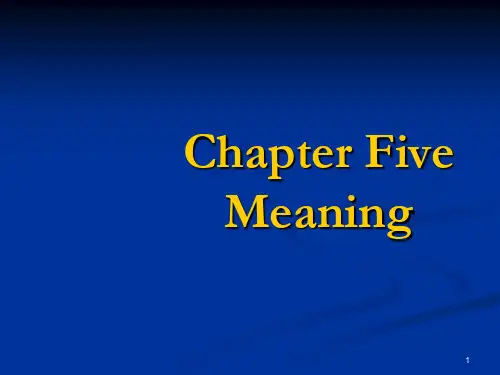
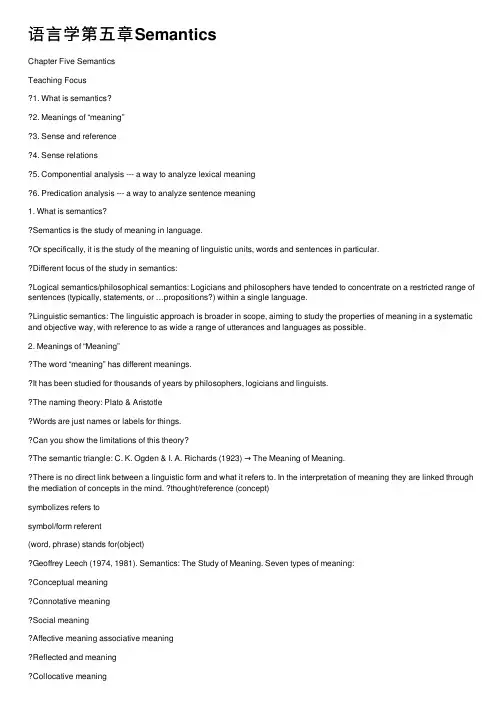
语⾔学第五章SemanticsChapter Five SemanticsTeaching Focus1. What is semantics2. Meanings of “meaning”3. Sense and reference4. Sense relations5. Componential analysis --- a way to analyze lexical meaning6. Predication analysis --- a way to analyze sentence meaning1. What is semantics?Semantics is the study of meaning in language.Or specifically, it is the study of the meaning of linguistic units, words and sentences in particular.Different focus of the study in semantics:Logical semantics/philosophical semantics: Logicians and philosophers have tended to concentrate on a restricted range of sentences (typically, statements, or …propositions?) within a single language.Linguistic semantics: The linguistic approach is broader in scope, aiming to study the properties of meaning in a systematic and objective way, with reference to as wide a range of utterances and languages as possible.2. Meanings of “Meaning”The word “meaning” has different meanings.It has been studied for thousands of years by philosophers, logicians and linguists.The naming theory: Plato & AristotleWords are just names or labels for things.Can you show the limitations of this theoryThe semantic triangle: C. K. Ogden & I. A. Richards (1923) → The Meaning of Meaning.There is no direct link between a linguistic form and what it refers to. In the interpretation of meaning they are linked through the mediation of concepts in the mind. ?thought/reference (concept)symbolizes refers tosymbol/form referent(word, phrase) stands for(object)Geoffrey Leech (1974, 1981). Semantics: The Study of Meaning. Seven types of meaning:Conceptual meaningConnotative meaningSocial meaningAffective meaning associative meaningReflected and meaningCollocative meaningThematic meaning(1) Conceptual meaningIt makes the central part of meaning.Refers to logical, cognitive or denotative content.Concerned with the relationship between a word and the thing it denotes, or refers to.(2) Connotative meaningThe communicative value an expression has by virtue of what it refers to, over and above its purely conceptual content.A multitude of additional, non-criterial properties, including not only physical characteristics but also psychological and social properties, as well as typical features. ?Involving the …real world? experience one associates with an expression when one uses or hears it.Unstable: they vary considerably according to culture, historical period, and the experience of the individual.Any characteristic of the referent, identified subjectively or objectively, may contribute to the connotative meaning of the expression which denotes it.(3) Social meaningWhat a piece of language conveys about the social circumstances of its use.Dialect: the language of a geographical region or of a social class.Time: the language of the 18th c., etc.Province: language of law, of science, of advertising, etc.Status: polite, colloquial, slang, etc.Modality: language of memoranda, lectures, jokes, etc.Singularity: the style of Dickens, etc.domicile: very formal, official steed: poeticresidence: formal horse: generalabode: poetic nag: slanghome: general gee-gee: baby language (4) Affective meaningReflecting the personal feelings of the speaker, including his attitude to the listener, or his attitude to something he is talking about.Youre a vicious tyrant and a villainous reprobate, and I hate you for it!Im terribly sorry to interrupt, but I wonder if you would be so kind as to lower your voices a little. orWill you belt up.(5) Reflected meaningArises in cases of multiple conceptual meaning, when one sense of a word forms part of our response to another sense. When you hear …click the mouse twice, you think of Gerry being hit twice by Tom so you feel excited.Many taboo terms are result of this.(6) Collocative meaningThe associations a word acquires on account of the meanings of words which tend to occur in its environment.pretty: girl, boy, woman, flower, garden, colour, village, etc.handsome: boy, man, car, vessel, overcoat, airliner, typewriter, etc.(7) Thematic meaningWhat is communicated by the way in which a speaker or writer organizes the message, in terms of ordering, focus, and emphasis.Mrs Bessie Smith donated the first prize.The first prize was donated by Mrs Bessie Smith.They stopped at the end of the corridor.At the end of the corridor, they stopped.3. Sense and referenceSense and reference are two terms often encountered in the study of word meaning. They are two related but different aspects of meaning.Sense is concerned with the inherent meaning of the linguistic form. It is the collection of all the features of the linguistic form; it is abstract and de-contextualized. It is the aspect of meaning dictionary compilers are interested in.Reference means what a linguistic form refers to in the real, physical world; it deals with the relationship between the linguistic element and the non-linguistic world of experience.Every word has a sense, but not every word has a reference.Grammatical words like but, if ,and do not refer to anything. And words like God, ghost and dragon refer to imaginary things. Therefore it is suggested that we should study meaning in terms of sense rather than reference.4. Sense relationsSynonymygradableAntonymy complementaryconverseHyponymyPolysemy4.1 SynonymySynonymy refers to the sameness or close similarity of meaning. Words that are close in meaning are called synonyms. Complete synonyms are rare. According to the way they differ, synonyms can be divided into the following groups:i. Dialectal synonyms --- used in different regional dialectsBritish English American Englishautumn falllift elevatorflat apartmenttube undergroundii. Stylistic synonyms --- differing in stylekid, child, offspringkick the bucket, pop off, die, pass away, deceaseiii. Synonyms that differ in their emotive or evaluative meaningcollaborator, accompliceiv. Collocational synonymsaccuse, chargev. Semantically different synonymssurprise, amaze, astound4.2 AntonymyThe term antonymy is used for oppositeness of meaning. Words that are opposite in meaning are antonyms.There are three types of antonyms.i. Gradable: Can be modified by adverbs of degree like very; Can have comparative forms; Can be asked with how. good, badyoung, oldhot, coldii. Complementary: the denial of one member of the pair implies the assertion of the other.alive, deadmale, femalepresent, absentiii. Converse or relational: exhibit the reversal of a relationship between the pair; one presupposes the other. husband, wifebuy, sellbefore, after4.3 HyponymyHyponymy refers to the sense relation between a more general word and a more specific word. It is a kind of inclusiveness. Superordinate: the more general wordHyponyms: the more specific wordsCo-hyponyms: hyponyms of the same superordinateflower, rose, lilyanimal, cat, dogfurniture, bed, desk4.4 PolysemyPolysemy refers to the sense relation that the same one word has more than one meaning. Such a word is called a polysemic word.table: a piece of furniture; orderly arrangement of facts, figures5. Componential analysis---a way to analyze lexical meaningComponential analysis is a way proposed by the structural semanticists to analyze word meaning.The approach is based upon the belief that the meaning of a word can be dissected into meaning components, calledsemantic features.HUMANman (ADULT, MALE)woman (ADULT, FEMALE)boy (NON-ADULT, MALE)girl (NON-ADULT, FEMALE)father: PARENT (x, y) & MALE (x)x is a parent of y, and x is male.take: CAUSE (x, (HA VE (x, y)))x causes x to have y.give: CAUSE (x, (~HA VE (x, y)))x causes x not to have y.Componential analysis provides an insight into the meaning of words and a way to study the relationships between words that are related in meaning.6. Predication analysis --- a way to analyze sentence meaningThe meaning of a sentence is obviously related to the meanings of the words used in it, but it is also obvious that sentence meaning is not simply the sum total of the words.Predication analysis: proposed by the British linguist G. LeechThe basic unit in this method is called prediction. It is the abstraction of the meaning of a sentence.A predication consists of argument(s) and predicate.An argument is logical participant in a predication, largely identical with the nominal element(s) in a sentence.A predicate is something said about an argument or it states the logical relation linking the arguments in a sentence. Tom smokes.Tom is smoking.Tom has been smoking. TOM (SMOKE)Does Tom smokingTom does not smoke. argument predicateKids like apples. → KID, APPLE (LIKE)It is hot. → (BE HOT)AssignmentsHow can words opposite in meaning be classified To which category does each of the following pairs of antonyms belong?north/south vacant/occupiedliterate/illiterate above/belowdoctor/patient wide/narrowpoor/rich father/daughterhonest/dishonest normal/abnormalExercisesI. Multiple choice.1. The naming theory seems applicable to ___ only.A. verbsB. adjectivesC. adverbsD. nouns2. Hyponyms of the superordinate “flower” do not include “___”.A. wardrobeB. tulipC. lilyD. rose3. Predication analysis is a way to analyze ___ meaning.A. phonemeB. wordC. phraseD. sentenceII. Make judgments (true or false)1. In the diagram of the classic semantic triangle, the word “symbol” refers to the object in the world of experience.2. When the same one word has more than one meaning we call it a polysemic word.3. Complete synonyms, i.e. synonyms that are mutually substitutable under all circumstances, are rare in English.。
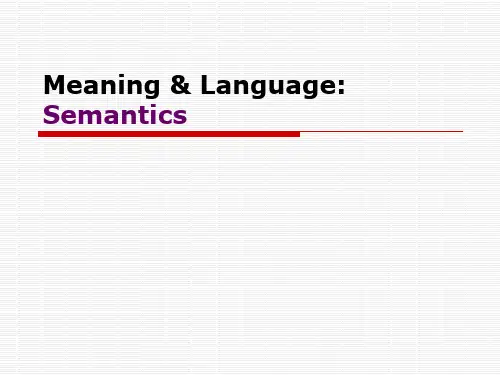
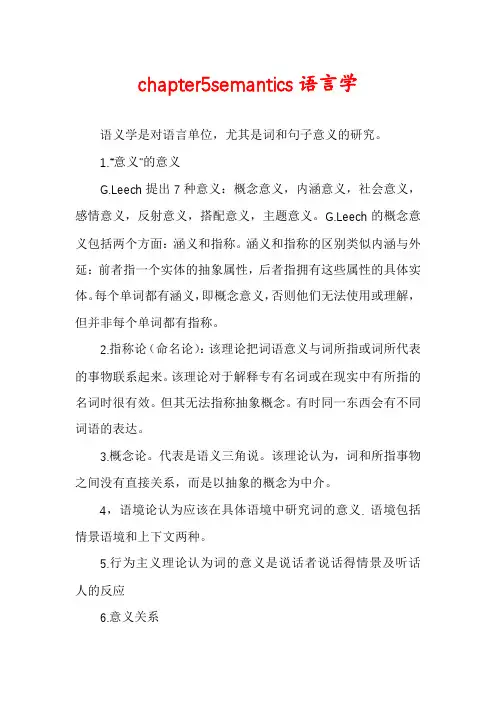
chapter5semantics语言学语义学是对语言单位,尤其是词和句子意义的研究。
1.“意义”的意义G.Leech提出7种意义:概念意义,内涵意义,社会意义,感情意义,反射意义,搭配意义,主题意义。
G.Leech的概念意义包括两个方面:涵义和指称。
涵义和指称的区别类似内涵与外延:前者指一个实体的抽象属性,后者指拥有这些属性的具体实体。
每个单词都有涵义,即概念意义,否则他们无法使用或理解,但并非每个单词都有指称。
2.指称论(命名论):该理论把词语意义与词所指或词所代表的事物联系起来。
该理论对于解释专有名词或在现实中有所指的名词时很有效。
但其无法指称抽象概念。
有时同一东西会有不同词语的表达。
3.概念论。
代表是语义三角说。
该理论认为,词和所指事物之间没有直接关系,而是以抽象的概念为中介。
4,语境论认为应该在具体语境中研究词的意义. 语境包括情景语境和上下文两种。
5.行为主义理论认为词的意义是说话者说话得情景及听话人的反应6.意义关系词语词之间的主要意义关系:相同关系,相反关系,包含关系a.同义关系。
完全同义关系很少,所谓的同一都依赖语境,并总在某方面不同。
(方言,内涵,文体等)b.反义关系主要包括:等级反义关系,互补反义关系,关系反义关系。
1)等级反义的特点:第一,否定一方并不必然是肯定另一方,还有中间状态;第二,没有绝对评判标准,标准随对象而改变。
第三,通常用其中表示较高程度的词来覆盖整个量级。
覆盖性词被称为“无标记的”,即一般性的;被覆盖词被称为“有标记的”,即特殊的。
一般使用覆盖性词语。
一旦使用被覆盖词语,表示有某种特殊的、不一般的情况。
第四,可用very修饰,可有比较级最高级2)互补反义关系,第一,肯定一方意味着否定另一方。
反之亦然。
第二,不用very修饰,没有比较级最高级。
第三,评判标准绝对。
没有覆盖性词语3)关系(反向)反义关系,表现两个实体间的一种反向关系,不构成肯否定对立。
一个预设着另一个的存在。
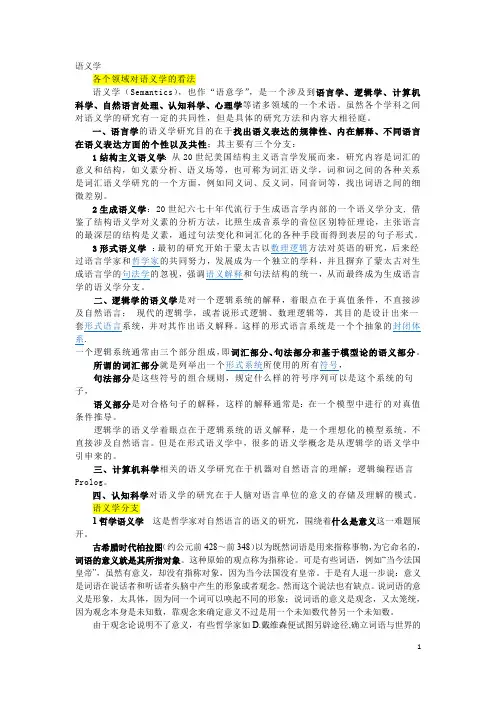
语义学各个领域对语义学的看法语义学(Semantics),也作“语意学”,是一个涉及到语言学、逻辑学、计算机科学、自然语言处理、认知科学、心理学等诸多领域的一个术语。
虽然各个学科之间对语义学的研究有一定的共同性,但是具体的研究方法和内容大相径庭。
四、认知科学对语义学的研究在于人脑对语言单位的意义的存储及理解的模式。
语义学分支1哲学语义学 这是哲学家对自然语言的语义的研究,围绕着什么是意义这一难题展开。
古希腊时代柏拉图(约公元前428~前348)以为既然词语是用来指称事物,为它命名的,词语的意义就是其所指对象。
这种原始的观点称为指称论。
可是有些词语,例如“当今法国皇帝”,虽然有意义,却没有指称对象,因为当今法国没有皇帝。
于是有人退一步说:意义是词语在说话者和听话者头脑中产生的形象或者观念。
然而这个说法也有缺点。
说词语的意义是形象,太具体,因为同一个词可以唤起不同的形象;说词语的意义是观念,又太笼统,因为观念本身是未知数,靠观念来确定意义不过是用一个未知数代替另一个未知数。
由于观念论说明不了意义,有些哲学家如D.戴维森便试图另辟途径,确立词语与世界的联系。
他们提出, 语句的意义与命题的真假有关。
这种观点称为真值论。
在真值论基础上发展出真值条件语义学,可能世界语义学及各种模式 -理论语义学。
维特根斯坦(1889~1951)反对真值论,他认为词的意义是它在语言中的用法。
他的理论叫做用法论。
用法论不象真值论那么狭窄,因为许多语句没有所谓真值,如疑问句、祈使句都无所谓真假,但是任何词语必有一定的用法。
可是用法论也有缺陷,困为“用法”的概念不明确。
后期的语言游戏论,认为“语言游戏论=自然语言分析+心理行为分析”。
维特根斯坦后期的转变不仅是语言基础的转变———从理想语言转到自然语言,也是分析方法的转变———从单纯的语言分析转到语言分析与心理分析的结合。
英国哲学家J.L.奥斯汀 (1911~1960)也反对真值论,他从另一个角度来弥补真值论的不足,他认为说话不仅是“言”,而且是“行”,因而话语有双重作用,一是陈述命题,二是起命令、请求、许愿、警告之类的言外作用。
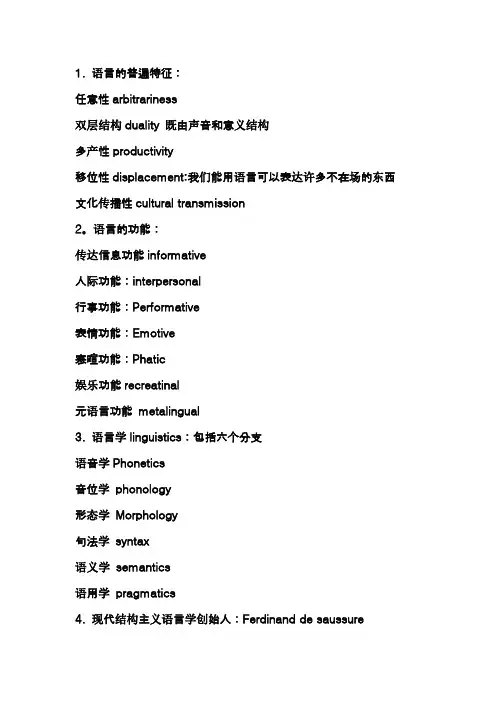
1. 语言的普遍特征:任意性arbitrariness双层结构duality 既由声音和意义结构多产性productivity移位性displacement:我们能用语言可以表达许多不在场的东西文化传播性cultural transmission2。
语言的功能:传达信息功能informative人际功能:interpersonal行事功能:Performative表情功能:Em otive寒暄功能:Phatic娱乐功能recreatinal元语言功能m etalingual3. 语言学linguistics:包括六个分支语音学Phonetics音位学phonology形态学M orphology句法学syntax语义学semantics语用学pragmatics4. 现代结构主义语言学创始人:Ferdinand de saussure提出语言学中最重要的概念对之一:语言与言语language and parole ,语言之语言系统的整体,言语则只待某个个体在实际语言使用环境中说出的具体话语5. 语法创始人:Noam Chomsky提出概念语言能力与语言运用competence and performance1. Which of the following statements can be used to describe displacement. one of the unique properties of language:a. we can easily teach our children to learn a certain languageb. we can use both 'shu' and 'tree' to describe the same thing.c. we can u se language to refer to something not presentd. we can produce sentences that have never been heard before.2.What is the most important function of language?a. interpersonalb. phaticc. informatived.metallingual3.The function of the sentence "A nice day, isn't it ?"is __a informativeb. phaticc. directived. performative4.The distinction between competence and performance isproposed by __a saussureb. hallidayc. chomskyd. the prague school5. Who put forward the distinction between language and parole?a. saussureb. chomskyc. hallidayd anomymous第二节语音学1.发音器官由声带the vocal cords和三个回声腔组成2.辅音consonant:there is an obstruction of the air stream at some point of the vocal tract.3.辅音的发音方式爆破音complete obstruction鼻音nasals破裂音plosives部分阻塞辅音partial obstruction擦音fricatives破擦音affricates等4.辅音清浊特征voicing辅音的送气特征aspiration5.元音vowel分类标准舌翘位置,舌高和嘴唇的形状6双元音diphthongs,有元音过渡 vowel glides1. Articulatory phonetics mainly studies __.a. the physical properties of the sounds produced in speechb. the perception of soundsc. the combination of soundsd. the production of sounds2. The distinction between vowel s and consonants lies in __a. the place of articulationb.the obstruction f airstreamc. the position of the tongued. the shape of the lips3. What is the common factor of the three sounds: p, k ta. voicelessb. spreadc.voicedd.nasal4. What phonetic feature distinguish the p in please and the p in speak?a. voicingb. aspirationc.roundnessd. nasality5.Which of the following is not a distinctive feature in English?a. voicingb.nasalc. approximationd. aspiration6.The phonological features of the consonant k are __a. voiced stopb. voiceless stopc. voiced fricatived. voiceless fricative7.p is divverent from k in __a. the manner of articulationb. the shape of the lipsc. the vibration of the vocal cordsd.the palce of articualtion8.Vibration of the vocal cords results in __a. aspirationb.nasalityc. obstructiond. voicing第三节音位学phonology1.音位学与语音学的区别:语音学着重于语音的自然属性,主要关注所有语言中人可能发出的所有声音;音位学则强调语音的社会功能,其对象是某一种语言中可以用来组合成词句的那些语音。
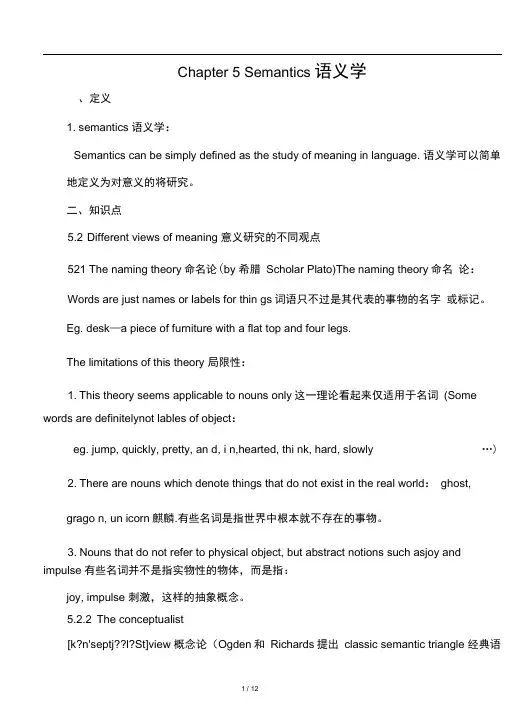
Chapter 5 Semantics 语义学、定义1. semantics 语义学:Semantics can be simply defined as the study of meaning in language. 语义学可以简单地定义为对意义的将研究。
二、知识点5.2 Different views of meaning 意义研究的不同观点521 The naming theory命名论(by 希腊Scholar Plato)The naming theory命名论:Words are just names or labels for thin gs词语只不过是其代表的事物的名字或标记。
Eg. desk—a piece of furniture with a flat top and four legs.The limitations of this theory 局限性:1. This theory seems applicable to nouns only这一理论看起来仅适用于名词(Some words are definitelynot lables of object:eg. jump, quickly, pretty, an d, i n,hearted, thi nk, hard, slowly …)2. There are nouns which denote things that do not exist in the real world: ghost,grago n, un icorn麒麟.有些名词是指世界中根本就不存在的事物。
3. Nouns that do not refer to physical object, but abstract notions such asjoy and impulse有些名词并不是指实物性的物体,而是指:joy, impulse 刺激,这样的抽象概念。
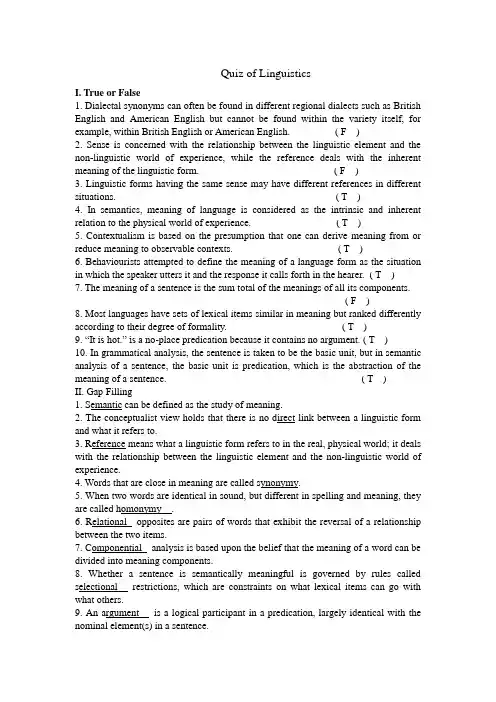
Quiz of LinguisticsI. True or False1. Dialectal synonyms can often be found in different regional dialects such as British English and American English but cannot be found within the variety itself, for example, within British English or American English. ( F )2. Sense is concerned with the relationship between the linguistic element and the non-linguistic world of experience, while the reference deals with the inherent meaning of the linguistic form. ( F )3. Linguistic forms having the same sense may have different references in different situations. ( T )4. In semantics, meaning of language is considered as the intrinsic and inherent relation to the physical world of experience. ( T )5. Contextualism is based on the presumption that one can derive meaning from or reduce meaning to observable contexts. ( T )6. Behaviourists attempted to define the meaning of a language form as the situation in which the speaker utters it and the response it calls forth in the hearer. ( T )7. The meaning of a sentence is the sum total of the meanings of all its components.( F )8. Most languages have sets of lexical items similar in meaning but ranked differently according to their degree of formality. ( T )9. “It is hot.” is a no-place predication because it contains no argument. ( T )10. In grammatical analysis, the sentence is taken to be the basic unit, but in semantic analysis of a sentence, the basic unit is predication, which is the abstraction of the meaning of a sentence. ( T )II. Gap Filling1. Semantic can be defined as the study of meaning.2. The conceptualist view holds that there is no direct link between a linguistic form and what it refers to.3. Reference means what a linguistic form refers to in the real, physical world; it deals with the relationship between the linguistic element and the non-linguistic world of experience.4. Words that are close in meaning are called synonymy.5. When two words are identical in sound, but different in spelling and meaning, they are called homonymy .6. Relational opposites are pairs of words that exhibit the reversal of a relationship between the two items.7. Componential analysis is based upon the belief that the meaning of a word can be divided into meaning components.8. Whether a sentence is semantically meaningful is governed by rules called selectional restrictions, which are constraints on what lexical items can go with what others.9. An argument is a logical participant in a predication, largely identical with the nominal element(s) in a sentence.10. According to the name theory of meaning, the words in a lan­guage are taken to be labels of the objects they stand for.III. Multiple Choice Items1. "Can I borrow your bike?" ___ "You have a bike." ( D )A、is synonymous withB、is inconsistent withC、entailsD、presupposes2. The pair of words “lend” and “borrow” are ___.( B )A. gradable oppositesB. relational oppositesC. co-hyponymsD. synonyms3. A word with several meanings is called __word. ( A )A.a polysemousB.a synonymousC.an abnormalD.a multiple4. The semantic components of the word “gentleman” can be expressed as __.( B )A.+animate,+male,+human,-adultB.+animate,+male,+human,+adultC.+animate,-male,+human,-adultD.+animate,-male,+human,+adult5. The phenomenon that words having different meanings have the same form is called ______. ( D )A.polysemyB.hyponymyC.antonymyD.homonymy6. One way to analyze lexical meaning is ______. ( C )A. predication analysisB. stylistic analysisC. componential analysisD. proposition analysis7. Synonyms are classified into several kinds. The kind to which“girl”and“lass” belong is called ______ synonyms. ( B )A. stylisticB. dialectalC. emotiveD. collocational8. “Sweets” and “candy” are used respectively in Britain in and Am erica, but refer to the same thing. The words are ______ synonyms. ( B )A. collocationalB. dialectalC. completeD. stylistic9. “How fast did he drive when he ran the red light?” _____ “He ran the red light”. ( D )A. entailsB. contradictsC. presupposesD. includes10. Predication analysis is a way to analyze _______ meaning. ( D )A.phonemeB.wordC.phraseD.sentence11. The naming theory is advanced by ________. ( A )A. PlatoB. BloomfieldC. Geoffrey LeechD. Firth12. “We shall know a word by the company it keeps.” This statement represents _______. ( B )A. the conceptualist viewB. contexutalismC. the naming theoryD. behaviourism13. Which of the following is not true? ( D )A. Sense is concerned with the inherent meaning of the linguistic form.B. Sense is the collection of all the features of the linguistic form.C. Sense is abstract and decontextualized.D. Sense is the aspect of meaning dictionary compilers are not interested in.14. “Can I borrow your bike?”_______ “You have a bike.” ( D )A. is synonymous withB. is inconsistent withC. entailsD. presupposes15. ___________ is a way in which the meaning of a word can be dissected into meaning components, called semantic features. ( B )A. Predication analysisB. Componential analysisC. Phonemic analysisD. Grammatical analysis16. “Alive” and “dead” are ______________. ( C )A. gradable antonymsB. relational oppositesC. complementary antonymsD. None of the above17. _________ deals with the relationship between the linguistic element and the non-linguistic world of experience. ( A )A. ReferenceB. ConceptC. SemanticsD. Sense18. ___________ refers to the phenomenon that words having different meanings have the same form. ( C )A. PolysemyB. SynonymyC. HomonymyD. Hyponymy19. Words that are close in meaning are called ______________. ( D )A. homonymsB. polysemyC. hyponymsD. synonyms20. The grammaticality of a sentence is governed by _______. ( A )A. grammatical rulesB. selectional restrictionsC. semantic rulesD. semantic features Scores: 97.5IV. Term Explanation1. semantics2. sense3. reference4. synonymy5. polysemy6. homonymy7. homophones8. Homographs9. complete homonyms10. hyponymy11. antonymy12 componential analysis13. grammatical meaning14. predication15. Argument16. predicate17. two-place predicationⅤ. Answer the following questions:1. Why do we say that meaning of a sentence is not the sum total of the meanings of all its components?2. What is componential analysis? Illustrate it with examples.3. How do you distinguish between entailment and presupposition in terms of truth values?4. How do you account for such sense relations between sentences as synonymous relation, inconsistent relation in terms of truth values?5. According to the way synonyms differ, how many groups can we classify synonyms into? Illustrate them with examples.6. What are the major views concerning the study of meaning? How they differ?。
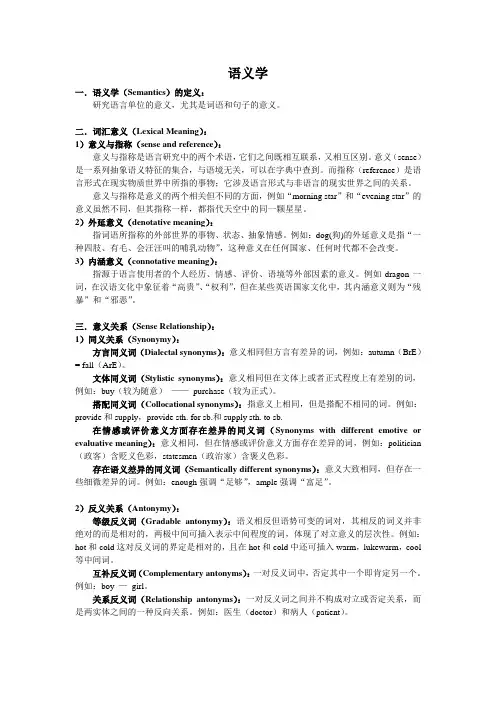
语义学一.语义学(Semantics)的定义:研究语言单位的意义,尤其是词语和句子的意义。
二.词汇意义(Lexical Meaning):1)意义与指称(sense and reference):意义与指称是语言研究中的两个术语,它们之间既相互联系,又相互区别。
意义(sense)是一系列抽象语义特征的集合,与语境无关,可以在字典中查到。
而指称(reference)是语言形式在现实物质世界中所指的事物;它涉及语言形式与非语言的现实世界之间的关系。
意义与指称是意义的两个相关但不同的方面,例如“morning star”和“evening star”的意义虽然不同,但其指称一样,都指代天空中的同一颗星星。
2)外延意义(denotative meaning):指词语所指称的外部世界的事物、状态、抽象情感。
例如:dog(狗)的外延意义是指“一种四肢、有毛、会汪汪叫的哺乳动物”,这种意义在任何国家、任何时代都不会改变。
3)内涵意义(connotative meaning):指源于语言使用者的个人经历、情感、评价、语境等外部因素的意义。
例如dragon一词,在汉语文化中象征着“高贵”、“权利”,但在某些英语国家文化中,其内涵意义则为“残暴”和“邪恶”。
三.意义关系(Sense Relationship):1)同义关系(Synonymy):方言同义词(Dialectal synonyms):意义相同但方言有差异的词,例如:autumn(BrE)= fall(ArE)。
文体同义词(Stylistic synonyms):意义相同但在文体上或者正式程度上有差别的词,例如:buy(较为随意)——purchase(较为正式)。
搭配同义词(Collocational synonyms):指意义上相同,但是搭配不相同的词。
例如:provide和supply,provide sth. for sb.和supply sth. to sb.在情感或评价意义方面存在差异的同义词(Synonyms with different emotive or evaluative meaning):意义相同,但在情感或评价意义方面存在差异的词,例如:politician (政客)含贬义色彩,statesmen(政治家)含褒义色彩。
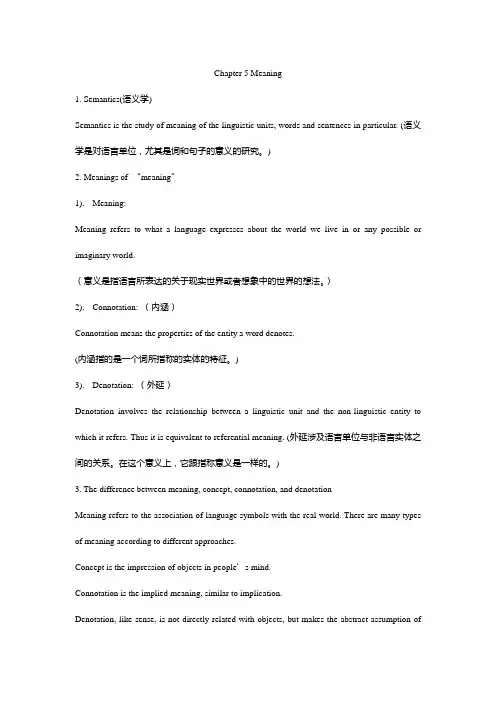
Chapter 5 Meaning1. Semantics(语义学)Semantics is the study of meaning of the linguistic units, words and sentences in particular. (语义学是对语言单位,尤其是词和句子的意义的研究。
)2. Meanings of “meaning”1). Meaning:Meaning refers to what a language expresses about the world we live in or any possible or imaginary world.(意义是指语言所表达的关于现实世界或者想象中的世界的想法。
)2). Connotation: (内涵)Connotation means the properties of the entity a word denotes.(内涵指的是一个词所指称的实体的特征。
)3). Denotation: (外延)Denotation involves the relationship between a linguistic unit and the non-linguistic entity to which it refers. Thus it is equivalent to referential meaning. (外延涉及语言单位与非语言实体之间的关系。
在这个意义上,它跟指称意义是一样的。
)3. The difference between meaning, concept, connotation, and denotationMeaning refers to the association of language symbols with the real world. There are many types of meaning according to different approaches.Concept is the impression of objects in people’s mind.Connotation is the implied meaning, similar to implication.Denotation, like sense, is not directly related with objects, but makes the abstract assumption ofthe real world.4. The referential theory1). DefinitionThe theory of meaning which relates the meaning of a word to the thing it refers to, or stands for, is known as the referential theory.(把词语意义跟它所指称或代表的事物联系起来的理论,叫做指称理论)2). The semantic triangle (语义三角)Ogden and Richards presented the classic “Semantic Triangle”as manifested in the following diagram。
Chapter 5 Semantics 语义学1.What is semantics?什么是语义学?Semantics can be simply defined as the study of meaning in language.语义学可定义为对语言意义的研究。
2.Some views concerning the study of meaning语义研究的几种主要理论1)The naming theory 命名论It was proposed by the ancient Greek scholar Plato. According to this theory, the linguistic forms or symbols, in other words, the words used in a language are taken to be labels of the objects they stand for. So words are just names or labels for things.命名论是最原始的语义理论,是古希腊学者柏拉图提出的。
该理论把词看作是该词所指事物的名称或标记。
2)The conceptualist view 意念论The conceptualist view holds that there is no direct link between a linguistic form and what it refers to; rather, in the interpretation of meaning they are linked through the mediation of concepts in the mind.意念论认为,语言形式及其所代表的对象之间(即语言与现实世界之间)没有直接联系;确切地说,在理解语义时,是通过大脑中存在意念这一中介物来联系的。
semantics含义和举例
Semantics是一个英语词汇,指的是语言学和逻辑学中与词义、句义以及语言表达的意义相关的概念和研究领域。
在语言学中,semantics研究词汇和句子的意义,并探讨词汇和句子之间的
关系。
在逻辑学中,semantics研究命题、谓词和推理等的意
义和语义逻辑。
举例:
1. 在语言学中,semantics可以用来解释词汇的意义。
比如,
英语单词"dog"的semantics是指代一种四肢的、长尾巴的、被
驯化且以人类为主要伙伴的哺乳动物。
2. 在逻辑学中,semantics可以用来解释谓词和推理的意义。
例如,谓词"是母亲"的semantics可以定义为"对于一个人x,
如果存在一个人y,y是x的孩子,则x是母亲"。
3. 在计算机科学中,semantics可以用来解释编程语言的意义。
比如,当编写一个计算两个数之和的程序时,semantics可以
定义为将两个数相加并返回结果的操作。
总而言之,semantics的含义涵盖了语言学、逻辑学和计算机
科学等多个学科领域。
它帮助我们理解和研究词汇、句子、命题以及计算机程序等的意义和语义关系。
Chapter 6 SemanticsSemantics: it is generally defined as the study of inherence or intrinsic meaning, the meaning in isolation from the context.The naming theory:命名论it is one of the oldest notions concerning meaning proposed by Plato, which holds the view that the relationship between linguistic forms and what they stand for is one of naming. Its defaults: firstly, the theory seems applicable to nouns only. Secondly, even within the category of nouns, there are nouns which denote things that do not exist in the real world at all or things that do not refer to physical objects, but abstract notions. Finally, some words may have different meanings in different contexts while the same reference may have different names such as “the morning star” and “the evening star”The conceptualist theory: 意念论C. K .Ogden Richard created the semantic triangle to show the indirect relationship between symbols and their supposed referents.Symbol: it refers to the linguistic elements such as word or sentence.Referent: it refers to the object in the world of experience.Context: it refers to what comes before and after a word, phrase, statement, etc. helping to fix the meaning; or refers to circumstances in which an event occurs. Contextualism :情境论、语境论John FirthSituational context: it refers to the particular spatiotemporal situation in which an utterance occurs, the main components of which include, apart from the place and time of the utterance, the speaker and the hearer, the actions they are performing at the time, the various objects and events exists in the situation.The linguistic context: sometimes known as context, it includes a word’s co-occurrence or collocation with another word, which forms part of the “meaning” of a word, and, also the part of text that precedes and follows a particular utterance. For example, the meaning of the word “paper” differs in the two collocations of “a piece of paper” and“a white paper”。